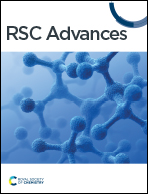Ligand effect on controlling the synthesis of branched gold nanomaterials against fusarium wilt diseases†
Abstract
The widespread wilt disease caused by Fusarium solani spp is a pressing problem affecting crop production and intensive farming. Strategic biocontrol of Fusarium solani spp using phytochemical mediated nano-materials is eco-friendly compared to harsh synthetic fungicides. The present study demonstrates the comparative dose effects of QPABA-derived branched gold nanomaterial (AuNF) and quercetin-mediated spherical gold nanoparticles (s-AuNPs) against Fusarium solani spp. Quercetin-para aminobenzoic acid (QPABA) was synthesized using reductive amination by reacting para-aminobenzoic acid with quercetin in an eco-friendly solvent at 25 °C. The structure elucidation was confirmed using 1H and 13C-NMR. TLC analysis showed that QPABA (Rf = 0.628) was more polar in water than quercetin (Rf = 0.714). The as-synthesized QPABA serves as a reducing and capping agent for the synthesis of gold nanoflowers (AuNFs) and gold nanostars (AuNSs). The UV-vis, XRD, and TEM confirmed the SPR peak of gold (550 nm) and gold element with a particle size distribution of 20–80 nm for the nanostars respectively. AuNFs exhibited a significant (P < 0.05) inhibitory effect against F. solani in a dose-dependent manner using Agar well diffusion. Nevertheless, spherical-AuNPs were not effective against F. solani. The inhibitory effect was influenced by the size, dose treatment, and particle shape. The minimum inhibitory concentration (MIC) value of AuNFs was 125.7 ± 0.22 μg mL−1. Our results indicate that AuNFs show considerable antifungal activity against F. solani as compared to spherical AuNPs. This study shows a greener synthesis of gold anisotropic nanostructures using QPAB, which holds promise for the treatment of fungal pathogens impacting agricultural productivity.



 Please wait while we load your content...
Please wait while we load your content...